Effective Strategies to Prevent Lawn Damage by Birds
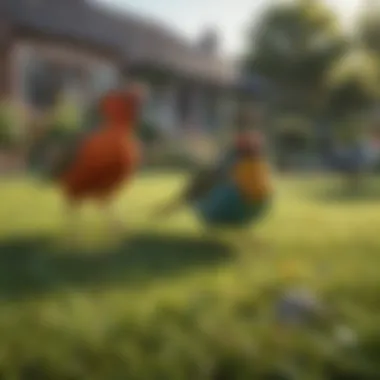

Intro
Birds can often be a nuisance for homeowners, particularly when they target lawns. The sight of birds digging into the grass can represent more than just a momentary frustration. It signals potential long-term damage to the aesthetic and health of the lawn. Understanding this problem requires an examination of why birds are attracted to lawns and what can be done to mitigate their impact effectively. This guide aims to outline suitable strategies while promoting a balance of nature and landscaping aesthetics.
Understanding Pests
Pests can take many forms, but in the context of birds damaging lawns, the definition is straightforward. Pests are organisms that may cause harm to plants, crops, or in this case, lawns. Birds often engage in behaviors, like pecking or digging, as they search for insects, seeds, or other food sources.
Importance of Pest Identification
Identifying the types of birds causing damage can be essential for effective management. Different species have varied feeding behaviors and preferences. For example, starlings may target lawns for grubs, while sparrows might feed on seeds.
Understanding these behaviors allows homeowners to tailor their prevention methods more effectively. Gathering information about local bird species enhances preventative efforts and limits damage.
Prevention Techniques
Preventing birds from damaging lawns involves a variety of strategies that can be employed in both residential and garden settings.
Home and Garden Preventative Measures
There are multiple approaches that homeowners can utilize to deter birds from damaging their lawns:
- Decoys and Visual Deterrents: Utilizing items like plastic owls or reflective tape can create an environment that feels unsafe for birds.
- Netting: Setting up bird netting over specific areas of the lawn can create a barrier that restricts access.
- Sound Devices: Consider using noise-emitting devices that repel birds; however, be cautious as these may also disturb other local wildlife.
Seasonal Prevention Tips
Bird behavior can fluctuate with seasons. Thus, timing is crucial:
- In spring, when nests are being built, consider avoiding chemical treatments that might drive birds away.
- During fall, trim grass to an appropriate height to discourage feeding and nesting.
Regular Maintenance
Maintaining a clean yard can also reduce attractions. Regularly removing fallen fruit and debris helps to minimize food sources.
Eco-Friendly Pest Control Solutions
Adopting sustainable methods for managing bird damage is essential for ecological balance.
Overview of Sustainable Practices
Using environmentally-friendly practices can not only deter birds but also enhance the overall health of your lawn. This can involve:
- Implementing a varied planting strategy to create natural barriers.
- Encouraging native species that attract fewer harmful pests can also supplement these efforts.
Natural Remedies and Their Effectiveness
Several natural remedies exist that can be effective:
- Spicy Mixtures: Spraying a diluted solution made from chili powder can deter birds from unwanted areas.
- Essential Oils: Using lemon or peppermint may repel birds effectively.
By implementing these practices, homeowners can preserve their lawns while maintaining harmony with local wildlife.
Synthesizing Information
Understanding birds' behavior, employing preventive measures, and focusing on eco-friendly solutions creates an effective approach for managing lawns. Homeowners are equipped with practical tools that prioritize lawn preservation while respecting the rightful place of birds in the ecosystem. This comprehensive understanding highlights the need for continuous monitoring and improvement in methods as conditions change.
Prologue to Bird Damage on Lawns
Birds are often seen as a delightful part of nature. However, their presence can pose challenges for homeowners aiming to maintain a pristine lawn. The impact of bird activities extends beyond mere aesthetics; it can lead to serious damage that affects both the health of grass and the overall landscape. Understanding why birds target lawns is imperative for implementing effective prevention strategies. By addressing bird-related issues, homeowners can protect their investment while fostering a sustainable environment.
Understanding the Issue
Birds may be drawn to lawns for diverse reasons. Their natural instincts drive them to seek food sources, which often include insects, seeds, and even young plants. When lawns are lush and green, they appear as a suitable habitat for foraging. This behavior can sometimes result in significant damage, such as unsightly holes and patches of bare soil.
Many homeowners fail to recognize the connection between lawn maintenance and bird attraction. A well-watered and fertilized lawn can seem inviting to birds. As they search for nourishment, they can disrupt the soil structure and uproot tender grass. Thus, awareness of this relationship is vital.
Types of Birds Typically Involved
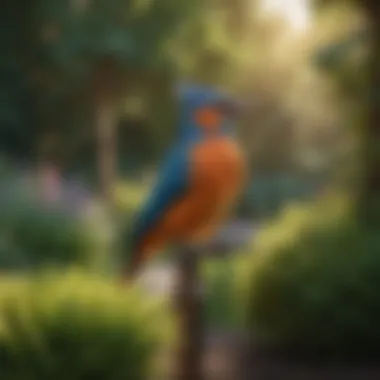
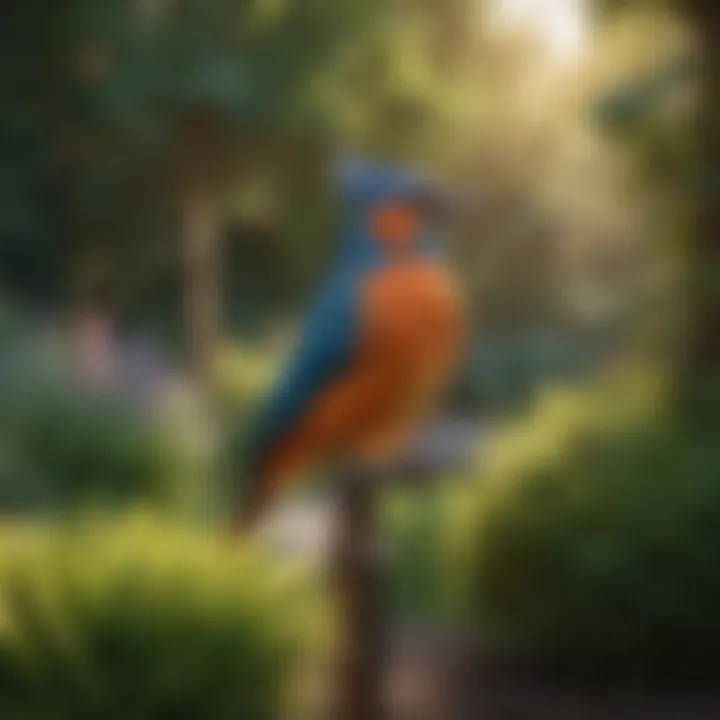
Not all birds are equally problematic. Specific species tend to show a preference for lawns, leading to damage.
- Starlings: Known for their gregarious nature, starlings can swarm in large numbers, gravely impacting lawn health.
- Robins: While generally viewed as benign, robins can dig into soil to find larvae and worms, which may harm grass roots.
- Sparrows: Often seen foraging for seeds, sparrows frequently target lawns with newly sprouted grass, resulting in further issues.
- Crows: Crows possess strong beaks ideal for digging. They can uproot young plants, causing long-term damage.
Recognizing these birds can help homeowners tailor their prevention methods. The more one knows about these species, the better equipped they are to defend their lawns against potential threats.
Recognizing Signs of Bird Damage
Understanding the signs of bird damage on your lawn is crucial. Early recognition can prevent further harm. Birds often exhibit specific behaviors that can indicate trouble. By being vigilant, homeowners can safeguard their lawns from severe damage and maintain an aesthetically pleasing yard.
Homeowners should be aware of the various signs that indicate birds are present and possibly causing harm. This awareness can also help in responding quickly, using appropriate measures to deter further damage.
Common Indicators of Damage
Various signs suggest birds have damaged your lawn. A key indicator includes patches of bare soil. If you see areas where grass is missing, birds might be foraging in those spaces.
Another indication can be irregular holes or divots, which birds create while searching for insects or grubs. Bird droppings are also a clear sign. Their droppings can lead to undesirable stains and unhealthy plants.
Some common signs to look for include:
- Uneven grass height: If certain areas are consistently shorter, this might signal bird activity.
- Soil tunneling or displacement: Check for loose soil or overturned grass; birds can cause significant disturbance.
- Presence of bird tracks: This can be a subtle, yet noticeable cause for concern.
These elements contribute not only to the appearance but also to the health of the lawn. Regular evaluations can help catch bird damage early, allowing homeowners to intervene effectively.
Assessing the Extent of Damage
Once signs of bird damage are identified, it’s important to assess how severe the impact is. Not all damage requires immediate action. Knowing how deep the issue runs helps in deciding the next steps.
Start by checking the size of the affected area. Is it localized, or does it cover a large section of your lawn? Additionally, consider the extent of the damage. Are there spots that appear completely bare, or are there just minor disturbances?
Another aspect is to observe the type of grass and its recovery rate. Some grasses might endure bird activity better than others. Determine if grass is wilting or showing signs of stress.
Some strategies in assessment include:
- Visual inspection: Walk around your lawn frequently to catch irregularities.
- Touch test: Checking the firmness of the soil can indicate if grubs are present and attracting birds.
- Timestamping observations: Note when birds appear. Understanding their patterns helps in long-term prevention.
By methodically evaluating the damage, homeowners can implement targeted strategies. After recognizing the signs of bird damage and assessing its extent, effective preventive measures can then be employed to foster a healthier lawn.
Bird Behavior and Its Impact
Understanding bird behavior is paramount for effective lawn protection. Birds often interact with lawns due to specific needs. By grasping their motivations and seasonal habits, homeowners can apply appropriate strategies to deter them. This section emphasizes the importance of recognizing these dynamics.
Motivations Behind Lawn Foraging
Birds forage on lawns for several reasons. Primarily, they search for food, which typically consists of insects, seeds, and other small organisms found in grass and soil. Lawns provide an accessible habitat for these food sources, making them attractive for birds looking to sustain themselves. Additionally, some birds may seek out worms or grubs during the warmer months when these insects become active.
Understanding these motivations helps in developing targeted deterrent strategies. For instance, if particular bird species are consuming grubs, treating the lawn with insecticides may be necessary. However, a comprehensive approach should consider the health of the ecosystem.
Regularly monitoring lawn conditions can also provide insight into bird activity patterns. Homeowners should assess the presence of insects and adjust lawn management practices accordingly. This proactive observation aids in maintaining a healthy lawn while minimizing bird-related damage.
Seasonal Patterns in Bird Activity
Seasonality greatly influences bird behavior. Many bird species migrate depending on the time of year. In the spring and summer, there tends to be an increase in foraging activity as birds build nests and raise their young. During these months, homeowners may notice more birds on their lawns. Understanding these patterns allows for effective timing in preventative measures.
On the other hand, as autumn approaches, some bird species begin to migrate south, reducing their presence in local areas. However, those that remain may start preparing for winter by seeking food sources to store.
Homeowners should consider these patterns when planning lawn care. Here’s what to keep in mind:
- Spring and Summer: Focus on protective measures to deter large groups of foraging birds. Implement physical barriers and plant repellent species.
- Autumn: Monitor lawns closely. This may also be the time to adjust pest control measures, catering to the specific species active during this period.
Recognizing the shift in bird behavior across seasons allows for a proactive approach in maintaining lawn integrity.
After understanding these aspects of bird behavior, it becomes evident that informed actions are key to preventing damage to lawns. With the right knowledge, homeowners can protect their lawns effectively, fostering a balance with nature.
Preventive Measures for Lawn Protection
Preventive measures for lawn protection are crucial for homeowners aiming to safeguard their outdoor spaces from bird damage. Applying these strategies can mitigate the adverse effects birds may have on lawns while allowing for a balanced interaction between nature and cultivated spaces. The right combination of preventive techniques can help maintain the aesthetic and health of lawns, ensuring that they flourish without significant interference from these feathered visitors.
Physical Barriers
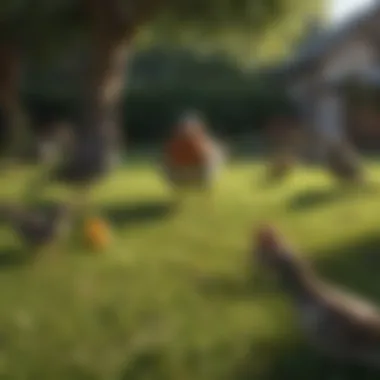
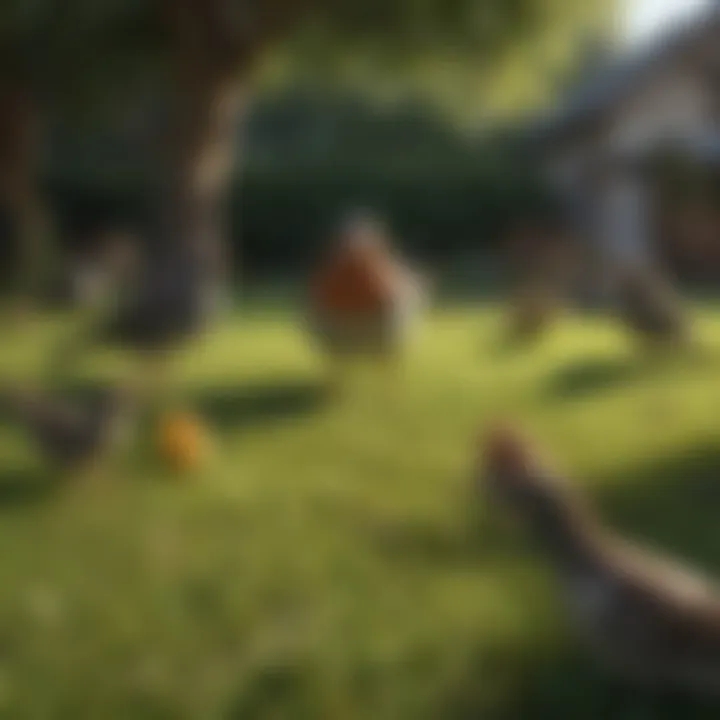
Physical barriers can be an effective first line of defense against birds. These methods create a physical obstruction that prevents birds from accessing the grass. Common forms of barriers include:
- Netting: Bird netting can be draped over specific areas of the lawn, especially where newly planted seeds are sown. This can deter birds from pecking at the ground. Ensure the netting is securely placed to avoid trapping any birds underneath.
- Fencing: Low fencing or wire barriers can also help. While larger birds may not be easily deterred by low fences, smaller species often will be. Make sure fence heights are appropriate for the specific target bird species.
- Row Covers: In garden beds, using row covers can shield young plants from foraging birds. These lightweight covers allow sunlight and moisture to reach plants while keeping birds away.
Implementing these physical barriers requires consideration of the type of birds frequenting your space. Identify the species that are causing issues to determine what barriers will be most effective. Physical barriers also need regular inspection and maintenance to ensure they remain effective over time.
Using Deterrent Devices
Using deterrent devices is another strategy to protect lawns. These devices create unexpected stimuli that encourage birds to avoid specific areas. There are a variety of such devices available:
- Scare Tactics: Visual scare devices, such as reflective tape or plastic owls, can be placed around the lawn. The threat posed by the predatory appearance of these decoys can effectively dissuade birds from landing.
- Sound Devices: Some homeowners find success with audio devices that emit bird distress calls or predator sounds. These sounds can create an auditory impression of danger and prompt birds to seek refuge elsewhere. Care should be taken to use these in moderation to avoid excessive disturbance to the area.
- Movement Devices: Wind spinners or kites can introduce motion into the environment, which can startle birds. The unpredictable movement may make the space less appealing for birds to land.
When selecting deterrent devices, consider their placement and effectiveness. A combination of devices can yield better results than relying on a single method. Understanding the local bird population's behavior will also be essential in choosing the right deterrents.
"Preventive measures and strategies can create a balanced environment, allowing for the coexistence of birds and lush lawns without competition."
Overall, the combination of physical barriers and deterrent devices can significantly reduce bird damage to lawns. These measures foster an environment conducive to lawn growth while respecting the natural behaviors of the bird species in your area.
Natural Deterrents to Consider
Natural deterrents play a crucial role in preventing birds from causing damage to your lawn. They offer a sustainable approach to bird control, relying on non-invasive methods that encourage coexistence with wildlife. Utilizing these strategies not only protects your lawn but also respects the natural ecosystem. By incorporating specific plants or employing sound and motion deterrents, homeowners can create an environment that is less appealing to unwanted birds while maintaining the area's aesthetic.
Plants that Repel Birds
Certain plants can naturally deter birds from being attracted to your lawn. For example, Coleus canina is often referred to as the "scare-dog plant." This plant emits an odor that birds find unpleasant, deterring them from nesting or foraging in your yard. Other plants like peppermint and rosemary also serve a dual purpose. They provide fragrance and culinary uses, while their strong scents can help keep birds at bay.
Additionally, consider integrating native species that birds typically avoid. These plants require less maintenance and are better suited for your local ecosystem. Some birds might not favor plants with thorny characteristics, such as holly or barberry.
Combining various plants can create a natural barrier, making your lawn less attractive to birds. Here are some options to think about:
- Thyme – its strong scent may deter some birds.
- Lavender – birds often prefer open spaces over dense herbal growth.
- Marigolds – the scent of marigolds can help repel birds as well as other pests.
By selecting the right varieties, you do not only enhance the biodiversity of your lawn but also deprive birds of preferred nesting and foraging locations.
Sound and Motion Deterrents
Another effective method is the use of sound and motion deterrents. Birds are naturally cautious creatures, and unexpected noises or movements can scare them away from your lawn. One common strategy includes the use of wind chimes or reflective surfaces, like aluminum foil or reflective tape. These create visual disturbances, which can be disorienting for birds approaching a feeding area.
Moreover, you may invest in electronic devices that emit sounds imitating bird distress signals, which can effectively lead to permanent displacement of unwanted birds. While choosing these options, it is important to consider:
- The appropriate timing of sound activation, as constant noise may lead birds to become accustomed.
- Placement of such devices, to maximize exposure without causing disturbances to your household.
Other options include decoys that mimic predator birds, like owls. These should be moved regularly to prevent birds from recognizing them as stationary objects.
Implementing these natural deterrents can significantly reduce instances of bird damage on your lawn without resorting to harmful chemicals or aggressive tactics, thus ensuring a more humane approach to lawn care.
Professional Solutions for Bird Control
Professional solutions for bird control play a critical role in protecting your lawn from potential damage caused by birds. The challenges posed by these creatures often exceed what homeowners can manage with simple deterrents or natural methods. Hiring a professional can provide targeted approaches that not only prevent damage but also ensure that your lawn remains healthy and vibrant.
When considering professional help, it is important to weigh the benefits such as expertise in bird behavior, knowledge of local regulations regarding wildlife, and ability to deploy effective deterrent systems. Birds can be persistent, and their feeding habits can lead to significant damage in a short time. Thus, timely intervention is essential.
When to Seek Expert Help
Determining when to seek expert assistance is crucial for effective bird control. Homeowners should consider bringing in professionals if:
- Damage is Extensive: Noticeable and widespread damage can indicate a more serious problem that may require specialized knowledge.
- Increased Bird Activity: Patterns such as sudden influxes or seasonal migrations should signal the need for intervention.
- Failures of DIY Methods: If home remedies and preventative measures are not providing relief, professional tools and strategies may be necessary.
- Desire for Long-Term Solutions: Experts can offer sustainable solutions that mitigate future issues rather than just short-term fixes.
By identifying these situations early, homeowners can prevent severe damage and costly repairs.
Evaluating Pest Control Services
Evaluating pest control services is an important process to ensure you select a provider suited for your needs. Here are some key factors to consider:
- Experience and Reputation: Check the company’s history and reviews from former clients. Established services with a good track record often provide more reliable results.
- Methods Used: Inquire about the strategies and tools they employ. Ensure they align with your ethics, especially regarding wildlife protection laws.
- Licensing and Certification: Valid licenses indicate that the service complies with local regulations and uses safe practices.
- Cost and Transparency: Obtain detailed quotes and ask about what the costs cover. Be wary of hidden fees that may arise later.
- Follow-Up Services: A good service will include follow-ups to monitor effectiveness and make adjustments to strategies as needed.
Prioritizing these considerations aids in selecting a bird control professional who will help you maintain a healthy lawn effectively.
"Investing in professional bird control services is not just about immediate results; it’s about fostering a long-lasting solution that respects both your property and local wildlife."
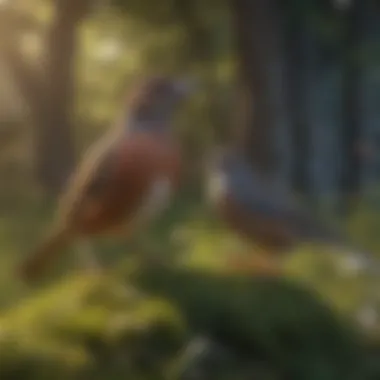

Through thoughtful evaluation and timely action, maintaining the integrity of your lawn while coexisting with bird populations becomes a manageable task.
Maintaining a Healthy Lawn
Maintaining a healthy lawn is crucial for preventing bird damage effectively. A robust lawn not only enhances the aesthetic appeal of your property but also encourages a balanced ecosystem that can mitigate the attraction for certain birds. Understanding how to cultivate and care for your lawn is essential for deterring birds while promoting its growth. By focusing on specific practices and landscaping choices, homeowners can sustain both their lawns and the local wildlife.
Best Practices for Lawn Care
Implementing best practices in lawn care can significantly reduce the likelihood of birds causing damage. Consider the following strategies:
- Regular Mowing: Keeping your lawn at a uniform height prevents birds from easily spotting grubs and insects. Frequent mowing encourages a dense and thick lawn that is less attractive to foraging birds.
- Irrigation Management: Watering your lawn correctly is vital. Over-watering can create an unhealthy environment, promoting disease and attracting pests that birds prey upon. Aim for deep but infrequent watering, which encourages deep root growth and a stronger lawn.
- Aeration: Regular aeration can help maintain soil health and allow for better nutrient absorption. This practice supports a vigorous lawn that can withstand stress, making it less susceptible to pest infestations.
- Regular Fertilization: Using a balanced fertilizer to nourish the grass can enhance growth. A well-fertilized lawn is strong and healthy, which can make it less appealing to birds looking for food sources.
- Pest Control: Conduct regular assessments to identify potential pest issues. Some birds forage to control pests, so managing the pest population can deter them from damaging your lawn.
Encouraging Biodiversity Within Your Lawn
Encouraging biodiversity not only fosters a healthy lawn ecosystem but also helps in keeping bird populations balanced. Here are some steps to promote biodiversity:
- Native Plants: Incorporate native plants and grasses into your lawn. These typically require less maintenance and create a natural habitat that supports local wildlife without attracting excessive bird activity.
- Pollinator Gardens: Planting flowers that attract pollinators can enrich the biodiversity of your lawn. Pollinators like bees and butterflies help maintain a healthy lawn ecosystem, which may reduce the reliance on birds who eat pests.
- Diverse Grass Varieties: Mixing up grass types can help improve the resilience of your lawn. Different species have unique strengths, which may appeal to various beneficial insects without overly attracting birds.
- Organic Practices: Emphasizing organic lawn care practices can promote healthier soil and grass. Avoiding harmful pesticides makes your lawn less inviting for birds looking for food but also prevents chemicals from leaching into the ground.
"A diverse lawn ecosystem is less prone to bird damage, as it naturally regulates itself."
Legal Considerations in Bird Control
When addressing bird damage in your lawn, it is crucial to understand the legal landscape surrounding bird control. This section aims to highlight the significance of adhering to wildlife protection laws and ensuring that any measures taken to deter birds are both humane and legally compliant.
Birds are often protected by various laws that recognize their role in the ecosystem. Failing to comply with these regulations can lead to severe consequences, including hefty fines. Therefore, becoming familiar with these laws is paramount for homeowners and gardeners who seek effective yet ethical solutions to protect their lawns.
Understanding Wildlife Protection Laws
Wildlife protection laws vary by region, but most places have regulations designed to safeguard local bird populations. These laws can dictate what actions can be legally taken against specific bird species. The Migratory Bird Treaty Act in the United States, for example, prohibits the killing, capturing, or harming of migratory birds without a permit.
Homeowners should actively seek knowledge about local regulations. This can often be achieved by consulting local wildlife agencies or researching online. Understanding these laws will guide you in selecting appropriate actions that do not violate legal stipulations. Additionally, by respecting wildlife regulations, individuals contribute to the conservation efforts aimed at sustaining healthy ecosystems.
A few key points include:
- Species Protection: Know which birds are protected in your area.
- Permits: Check if specific actions require permits.
- Controlled Measures: Familiarize yourself with legal deterrents.
Ethical Bird Control Practices
With knowledge of the legal framework, one can implement strategies that are not only effective but also ethical. Ethical bird control practices emphasize respect for wildlife and the environment. It's important to consider the long-term implications of bird control methods on bird populations and overall biodiversity.
Ethical practices center on non-lethal deterrents. Here are some effective strategies:
- Habitat Modification: Creating an environment that is less attractive to birds can be an effective preventive method. This may include altering plant selections or maintaining the lawn in a way that discourages foraging.
- Use of Deterrents: Utilizing non-lethal methods, such as reflective tape or bird-spike systems, can help keep birds at bay without causing harm.
- Public Awareness: Engage with community initiatives that support bird conservation efforts while addressing the issue of lawn damage. Collaborating with local wildlife organizations can lead to more sustainable solutions.
Implementing these ethical measures not only prevents damage to your lawn but also fosters a healthier relationship between humans and wildlife. By balancing lawn care and bird conservation, individuals play a vital role in promoting ecological well-being.
"Respecting wildlife and the laws that protect them is essential in creating a harmonious living environment for both birds and humans."
Closure
In summarizing the strategies to prevent birds from damaging lawns, it is crucial to recognize the balance we must strike between protecting our green spaces and respecting wildlife. Understanding bird behavior is paramount for effective lawn maintenance. Birds are generally attracted to lawns for food sources and habitat. Addressing their needs with alternative solutions is a proactive approach that benefits both parties.
The strategies discussed in the previous sections help homeowners establish a protected space against potential bird damage. Implementing physical barriers or deterrent devices can significantly reduce their presence. Meanwhile, natural solutions, such as planting specific flora that repels birds, offer a more holistic way of managing the situation.
Additionally, professional services provide specialized knowledge that can optimize yard health, simultaneously discouraging unwanted bird activity. Therefore, combining these methods creates a more resilient lawn system.
"A healthy lawn combined with considerate bird management leads to a thriving ecosystem in your backyard."
Homeowners should continuously monitor their lawns and adjust their strategies as necessary. Regular evaluations of the effectiveness of these methods will prove beneficial to maintain a balance in one's backyard.
Summarizing Effective Strategies
One of the key takeaways from this guide is that there is no one-size-fits-all solution. Effective lawn protection requires an understanding of individual circumstances. Here are some summarised strategies that have shown effectiveness:
- Physical Barriers: Use nets or fences that can hinder bird access.
- Deterrent Devices: Implement shiny objects or wind chimes that can discourage birds.
- Alternative Food Sources: Provide feeders that draw birds away from the lawn.
- Plant Selection: Incorporate plants known to repel birds in your landscaping effort.
- Seasonal Monitoring: Regularly check bird activity and adapt strategies accordingly.
These strategies must be tailored to fit specific yard conditions and bird species typically observed in the area. Remember, the intent is not to eliminate birds altogether but to protect the lawn while fostering a harmonious environment.
Final Thoughts on Coexistence with Birds
The relationship between homeowners and birds is intricate and often contentious. However, coexistence is possible when strategies are applied thoughtfully. A lawn, as a natural habitat, can thrive alongside bird populations through respectful management practices.
Emphasizing ethical considerations when engaging in bird control allows for a sustainable practice that promotes wildlife conservation. Homeowners should strive to appreciate the role birds play in the ecosystem while simultaneously safeguarding their property.
Through education and responsible actions, it is possible to cultivate a lawn that can withstand bird interference while contributing positively to the overall habitat quality. This approach not only enhances the aesthetic value of your lawn but also fosters a more biodiverse ecosystem, enriching the environment for all living beings.



